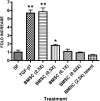Mesenchymal stem cells modulate lung injury
- PMID: 20427585
- PMCID: PMC3266019
- DOI: 10.1513/pats.200908-091RM
Mesenchymal stem cells modulate lung injury
Abstract
Mesenchymal stem cells (MSCs) have been shown to differentiate into a variety of mesenchymal cell types, including fibroblasts, myofibroblasts, osteoblasts, chondroblasts, adipocytes, and myoblasts, as well as epithelial cells. It has been shown that these cells can be recovered from bone marrow as well as umbilical cord blood, and they can be propagated, stored, and administered to animals and patients in clinical trials. It is clear that the cells engraft in the lung, and several laboratories have demonstrated an ameliorating effect in models of acute injury caused by LPS and in chronic lung injury induced by bleomycin and asbestos. However, it is not at all clear under what conditions these cells must be applied to provide an advantage and when using these cells might cause exacerbation of the lung injury. This brief review focuses on the biology of MSCs in vitro, how the cells have been used in some animal models, and the potential for their use in therapeutic strategies for diseases as diverse as lung cancer and interstitial fibrosis.
Figures


References
-
- Prockop DJ. Marrow stromal cells as stem cells for nonhematopoietic tissues. Science 1997;276:71–74. - PubMed
-
- Pittenger MF, Mackay AM, Beck SC, Jaiswal RK, Douglas R, Mosca JD, Moorman MA, Simonetti DW, Craig S, Marshak DR. Multilineage potential of adult human mesenchymal stem cells. Science 1999;284:143–147. - PubMed
-
- Abe S, Boyer C, Liu X, Wen FQ, Kobayashi T, Fang Q, Wang X, Hashimoto M, Sharp JG, Rennard SI. Cells derived from the circulation contribute to the repair of lung injury. Am J Respir Crit Care Med 2004;170:1158–1163. - PubMed
Publication types
MeSH terms
LinkOut - more resources
Full Text Sources
